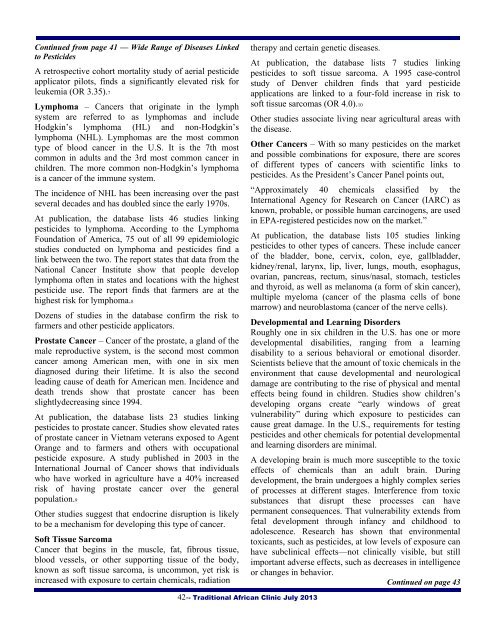toxicity - pesticides, herbicides and insecticides - Blackherbals.com
toxicity - pesticides, herbicides and insecticides - Blackherbals.com
toxicity - pesticides, herbicides and insecticides - Blackherbals.com
Create successful ePaper yourself
Turn your PDF publications into a flip-book with our unique Google optimized e-Paper software.
Continued from page 41 –– Wide Range of Diseases Linkedto PesticidesA retrospective cohort mortality study of aerial pesticideapplicator pilots, finds a significantly elevated risk forleukemia (OR 3.35).7Lymphoma – Cancers that originate in the lymphsystem are referred to as lymphomas <strong>and</strong> includeHodgkin’s lymphoma (HL) <strong>and</strong> non-Hodgkin’slymphoma (NHL). Lymphomas are the most <strong>com</strong>montype of blood cancer in the U.S. It is the 7th most<strong>com</strong>mon in adults <strong>and</strong> the 3rd most <strong>com</strong>mon cancer inchildren. The more <strong>com</strong>mon non-Hodgkin’s lymphomais a cancer of the immune system.The incidence of NHL has been increasing over the pastseveral decades <strong>and</strong> has doubled since the early 1970s.At publication, the database lists 46 studies linking<strong>pesticides</strong> to lymphoma. According to the LymphomaFoundation of America, 75 out of all 99 epidemiologicstudies conducted on lymphoma <strong>and</strong> <strong>pesticides</strong> find alink between the two. The report states that data from theNational Cancer Institute show that people developlymphoma often in states <strong>and</strong> locations with the highestpesticide use. The report finds that farmers are at thehighest risk for lymphoma.8Dozens of studies in the database confirm the risk tofarmers <strong>and</strong> other pesticide applicators.Prostate Cancer – Cancer of the prostate, a gl<strong>and</strong> of themale reproductive system, is the second most <strong>com</strong>moncancer among American men, with one in six mendiagnosed during their lifetime. It is also the secondleading cause of death for American men. Incidence <strong>and</strong>death trends show that prostate cancer has beenslightlydecreasing since 1994.At publication, the database lists 23 studies linking<strong>pesticides</strong> to prostate cancer. Studies show elevated ratesof prostate cancer in Vietnam veterans exposed to AgentOrange <strong>and</strong> to farmers <strong>and</strong> others with occupationalpesticide exposure. A study published in 2003 in theInternational Journal of Cancer shows that individualswho have worked in agriculture have a 40% increasedrisk of having prostate cancer over the generalpopulation.9Other studies suggest that endocrine disruption is likelyto be a mechanism for developing this type of cancer.Soft Tissue Sar<strong>com</strong>aCancer that begins in the muscle, fat, fibrous tissue,blood vessels, or other supporting tissue of the body,known as soft tissue sar<strong>com</strong>a, is un<strong>com</strong>mon, yet risk isincreased with exposure to certain chemicals, radiationtherapy <strong>and</strong> certain genetic diseases.At publication, the database lists 7 studies linking<strong>pesticides</strong> to soft tissue sar<strong>com</strong>a. A 1995 case-controlstudy of Denver children finds that yard pesticideapplications are linked to a four-fold increase in risk tosoft tissue sar<strong>com</strong>as (OR 4.0).10Other studies associate living near agricultural areas withthe disease.Other Cancers – With so many <strong>pesticides</strong> on the market<strong>and</strong> possible <strong>com</strong>binations for exposure, there are scoresof different types of cancers with scientific links to<strong>pesticides</strong>. As the President’s Cancer Panel points out,“Approximately 40 chemicals classified by theInternational Agency for Research on Cancer (IARC) asknown, probable, or possible human carcinogens, are usedin EPA-registered <strong>pesticides</strong> now on the market.”At publication, the database lists 105 studies linking<strong>pesticides</strong> to other types of cancers. These include cancerof the bladder, bone, cervix, colon, eye, gallbladder,kidney/renal, larynx, lip, liver, lungs, mouth, esophagus,ovarian, pancreas, rectum, sinus/nasal, stomach, testicles<strong>and</strong> thyroid, as well as melanoma (a form of skin cancer),multiple myeloma (cancer of the plasma cells of bonemarrow) <strong>and</strong> neuroblastoma (cancer of the nerve cells).Developmental <strong>and</strong> Learning DisordersRoughly one in six children in the U.S. has one or moredevelopmental disabilities, ranging from a learningdisability to a serious behavioral or emotional disorder.Scientists believe that the amount of toxic chemicals in theenvironment that cause developmental <strong>and</strong> neurologicaldamage are contributing to the rise of physical <strong>and</strong> mentaleffects being found in children. Studies show children’sdeveloping organs create “early windows of greatvulnerability” during which exposure to <strong>pesticides</strong> cancause great damage. In the U.S., requirements for testing<strong>pesticides</strong> <strong>and</strong> other chemicals for potential developmental<strong>and</strong> learning disorders are minimal.A developing brain is much more susceptible to the toxiceffects of chemicals than an adult brain. Duringdevelopment, the brain undergoes a highly <strong>com</strong>plex seriesof processes at different stages. Interference from toxicsubstances that disrupt these processes can havepermanent consequences. That vulnerability extends fromfetal development through infancy <strong>and</strong> childhood toadolescence. Research has shown that environmentaltoxicants, such as <strong>pesticides</strong>, at low levels of exposure canhave subclinical effects—not clinically visible, but stillimportant adverse effects, such as decreases in intelligenceor changes in behavior.Continued on page 4342-- Traditional African Clinic July 2013
















